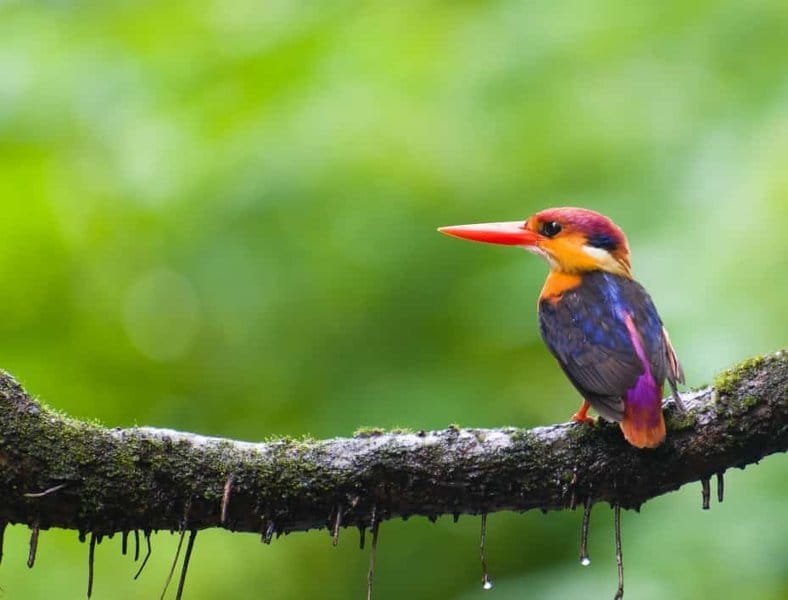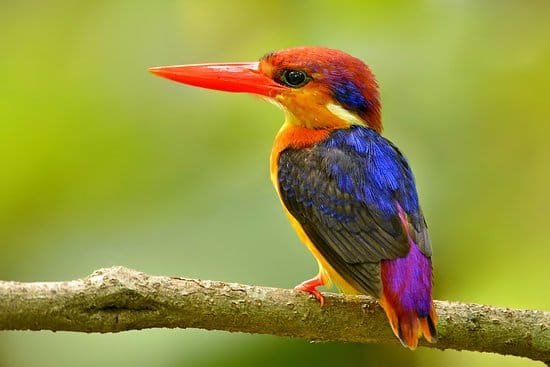The tropical rainforests of India are home to many incredible creatures, but few are as stunningly beautiful as the Oriental Dwarf Kingfisher.
Known for its brilliant plumage and swift, graceful movements, this tiny bird is often considered one of the most exquisite jewels of the Indian rainforest. Despite its small size, the Oriental Dwarf Kingfisher is a bird that leaves a lasting impression on anyone lucky enough to spot it. In this article, we will explore the fascinating world of this remarkable bird, its habitat, behavior, and why it’s deserving of its title as a “jewel” of the rainforests.
1. A Jewel of the Rainforest
The Oriental Dwarf Kingfisher (scientific name Ceyx erithaca) is often referred to as the “jewel of the Indian rainforests” because of its striking, jewel-like feathers. These birds boast a stunning mix of vibrant colors, including brilliant orange, blue, and purple hues. Their small size, which typically ranges from 12 to 14 cm in length, only adds to their charm, making them appear like colorful gems darting through the dense foliage.
This kingfisher is a master of camouflage, blending in perfectly with the lush green surroundings of the forest. Their bright plumage often shines like a beacon against the backdrop of the rainforest, making them one of the most sought-after sights for birdwatchers and nature lovers.
2. Habitat: A Love for the Rainforests
As their name suggests, Oriental Dwarf Kingfishers are primarily found in the rainforests and forested areas of the Indian subcontinent. They prefer the dense undergrowth of wet, tropical environments and can be spotted near slow-moving rivers, streams, and ponds. These birds are found in a variety of regions across India, particularly in the Western Ghats, the northeastern states, and parts of Sri Lanka.
The kingfishers’ need for clean, freshwater bodies is essential for their hunting strategy. They rely on these water sources to catch their prey, usually small fish and aquatic invertebrates. The dense vegetation around these water bodies also provides them with adequate cover to nest and hide from predators.
3. Diet: A Fishing Prodigy
True to its name, the Oriental Dwarf Kingfisher is an excellent fisherman. These birds are known for their impressive hunting techniques, which involve sitting quietly on a low branch or perched on a rock near the water, waiting patiently for prey. When they spot a potential meal—typically small fish, amphibians, or aquatic insects—they will dive into the water with remarkable speed and precision to catch their target.
Unlike some other kingfisher species that hunt from higher perches, the Oriental Dwarf Kingfisher prefers to stay close to the water surface. It uses its sharp beak to snatch up its prey with incredible accuracy. Their small size makes them highly agile and able to maneuver quickly, even in the dense rainforest undergrowth.
4. Mating and Nesting: Hidden Nests in the Forest
The mating season for the Oriental Dwarf Kingfisher typically occurs during the monsoon months, which coincide with the abundance of food and the lush growth of vegetation in the rainforests. These kingfishers are monogamous and tend to form long-term pair bonds. The males often impress the females by offering small fish as gifts, showcasing their skills as both hunters and providers.
When it comes to nesting, the Oriental Dwarf Kingfisher prefers to nest in natural holes along the banks of rivers or streams. They dig into the earth or use existing cavities in tree trunks, where they lay a small clutch of eggs. The female usually incubates the eggs while the male helps with hunting and bringing food to the nest. Both parents take turns feeding and caring for their chicks once they hatch.
5. Behavior: A Shy and Solitary Bird

Despite their vibrant appearance, the Oriental Dwarf Kingfisher is known to be a shy and elusive bird. These birds are not social and tend to live solitary lives, especially outside the breeding season. They prefer to keep to themselves, blending into the dense undergrowth and remaining hidden from the eyes of potential predators.
Due to their secretive nature, spotting an Oriental Dwarf Kingfisher can be a challenge. Birdwatchers and photographers often have to be patient and quiet, as sudden movements or loud sounds can scare the bird away. Their tendency to stay close to the water’s edge and their small size make them particularly difficult to detect, adding to the allure of this enigmatic species.
6. Coloration: Nature’s Masterpiece
The Oriental Dwarf Kingfisher’s bright plumage is truly one of the most beautiful aspects of this bird. The back and wings are a vivid shade of blue, while the underparts and face are adorned with bright orange and yellow hues. The combination of these colors makes the kingfisher resemble a tiny, living jewel. The contrast between the vibrant blue and orange is particularly striking, making the bird stand out as it darts between branches and across the water.
Interestingly, the colors of the Oriental Dwarf Kingfisher are not only for show. The bright colors help them communicate with other kingfishers, especially during the mating season when males display their brilliant plumage to attract potential mates. The bold colors also play a role in camouflage, blending in with the colorful flowers and foliage of the rainforest.
7. Conservation Status: A Vulnerable Species
While the Oriental Dwarf Kingfisher is not yet endangered, it is classified as a vulnerable species due to habitat loss and the degradation of its natural environment. Deforestation and the destruction of rainforests for agricultural purposes are significant threats to their population. Additionally, pollution of freshwater bodies, particularly from chemicals and plastic waste, can negatively impact their food sources and nesting sites.
Conservation efforts in India and Sri Lanka aim to protect the rainforests and river ecosystems that these kingfishers rely on. Protecting the habitats of the Oriental Dwarf Kingfisher is crucial for maintaining their population and ensuring that future generations can enjoy the beauty of these fascinating birds.
8. Why the Oriental Dwarf Kingfisher is a Birdwatcher’s Delight
For birdwatchers, the Oriental Dwarf Kingfisher is one of the most sought-after species. Its small size, vibrant colors, and elusive behavior make it a challenge to spot, but also a highly rewarding experience for those who are lucky enough to catch a glimpse. The bird’s unique presence in the rainforests of India offers birdwatchers the opportunity to explore some of the most biodiverse and stunning ecosystems on the planet.
Photography enthusiasts also love capturing the delicate beauty of the Oriental Dwarf Kingfisher. Its bright colors and graceful movements make for stunning photographs, and many professional photographers travel to India and Sri Lanka specifically to photograph this bird.
9. The Role of the Kingfisher in the Ecosystem
The Oriental Dwarf Kingfisher plays an important role in the rainforest ecosystem. By hunting aquatic insects, small fish, and other invertebrates, these birds help regulate populations of smaller creatures, keeping the ecosystem in balance. Their presence in the food chain also provides a source of food for larger predators, such as snakes and birds of prey.
Additionally, by nesting in tree cavities and along riverbanks, they help to maintain the health of freshwater ecosystems. Their activities contribute to the overall biodiversity of the area, which is crucial for the stability of the rainforest habitat.
10. A Symbol of Natural Beauty
The Oriental Dwarf Kingfisher is not just a beautiful bird; it is a symbol of the vibrant and diverse wildlife that can be found in India’s rainforests. Its stunning appearance, elusive nature, and essential role in the ecosystem make it one of the most cherished birds in the country. Efforts to preserve their habitats are vital for ensuring that future generations will continue to witness the majesty of the “jewel of the Indian rainforests.”

